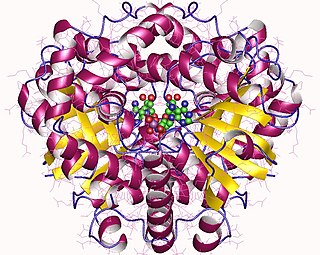| thiomorpholine-carboxylate dehydrogenase | |||||||||
|---|---|---|---|---|---|---|---|---|---|
| Identifiers | |||||||||
| EC no. | 1.5.1.25 | ||||||||
| CAS no. | 115232-54-7 | ||||||||
| Databases | |||||||||
| IntEnz | IntEnz view | ||||||||
| BRENDA | BRENDA entry | ||||||||
| ExPASy | NiceZyme view | ||||||||
| KEGG | KEGG entry | ||||||||
| MetaCyc | metabolic pathway | ||||||||
| PRIAM | profile | ||||||||
| PDB structures | RCSB PDB PDBe PDBsum | ||||||||
| Gene Ontology | AmiGO / QuickGO | ||||||||
| |||||||||
In enzymology, a thiomorpholine-carboxylate dehydrogenase (EC 1.5.1.25) is an enzyme that catalyzes the chemical reaction
- thiomorpholine 3-carboxylate + NAD(P)+ 3,4-dehydro-thiomorpholine-3-carboxylate + NAD(P)H + H+
The 3 substrates of this enzyme are thiomorpholine 3-carboxylate, NAD+, and NADP+, whereas its 4 products are 3,4-dehydro-thiomorpholine-3-carboxylate, NADH, NADPH, and H+.
This enzyme belongs to the family of oxidoreductases, specifically those acting on the CH-NH group of donors with NAD+ or NADP+ as acceptor. The systematic name of this enzyme class is thiomorpholine-3-carboxylate:NAD(P)+ 5,6-oxidoreductase. Other names in common use include ketimine reductase, and ketimine-reducing enzyme.
CRYM, a taxon-specific crystallin protein that also binds thyroid hormones has thiomorpholine-carboxylate dehydrogenase activity.



